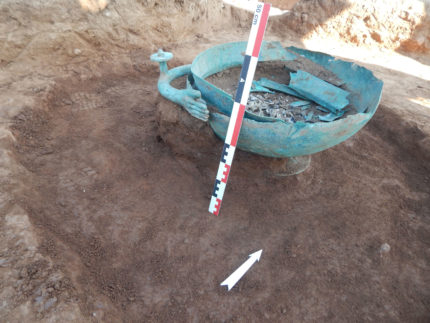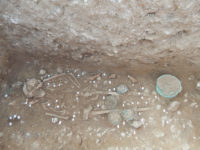 The ancient necropolis in Ahlanda, near Florina in the Greek region of West Macedonia has yielded more than 200 graves in just three months of excavations, several of them complete with important grave goods. The cemetery was used for centuries starting in the Late Bronze Age. The highest concentration of burials date to between the 6th and 3rd centuries B.C., but it was still very much active during the Byzantine years. The remains of two Roman farming operations have been discovered in the southern part of the site. Of the 209 burials discovered this summer, 131 date to the Byzantine era and 75 of them are from the Archaic period.
The ancient necropolis in Ahlanda, near Florina in the Greek region of West Macedonia has yielded more than 200 graves in just three months of excavations, several of them complete with important grave goods. The cemetery was used for centuries starting in the Late Bronze Age. The highest concentration of burials date to between the 6th and 3rd centuries B.C., but it was still very much active during the Byzantine years. The remains of two Roman farming operations have been discovered in the southern part of the site. Of the 209 burials discovered this summer, 131 date to the Byzantine era and 75 of them are from the Archaic period.
The cemetery was looted in antiquity and indeed, six of the graves unearthed this season had been relieved of their treasures by tomb raiders. They were stone-lined pits averaging 11 by 13 feet with inner masonry walls and cobblestone flooring. Even though their grave goods were long gone, the dimensions and construction of the tombs attest to the wealth and rank of the individuals interred in them.
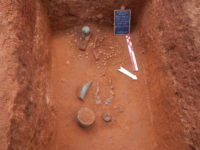 The site has been excavated every summer for six years, but this is the first year in which bronze helmets have been discovered. Four helmets of the Greco-Illyrian type, open-face helmets that covered the head and neck, used in Greece from around 700 B.C. until the early 5th century B.C., were unearthed in four different graves. One of them was a stand-out because it was richly attired with weapons and armaments. In addition to the helmet, the warrior grave contained two fragmented iron swords, two iron spearheads, bronze greaves a wide-mouth bronze vessel with decorative handles in the form of human hands. Cinerary remains inside the vessel indicate it was a secondary burial, one of five secondary burials, all of them cremations, found in the necropolis.
The site has been excavated every summer for six years, but this is the first year in which bronze helmets have been discovered. Four helmets of the Greco-Illyrian type, open-face helmets that covered the head and neck, used in Greece from around 700 B.C. until the early 5th century B.C., were unearthed in four different graves. One of them was a stand-out because it was richly attired with weapons and armaments. In addition to the helmet, the warrior grave contained two fragmented iron swords, two iron spearheads, bronze greaves a wide-mouth bronze vessel with decorative handles in the form of human hands. Cinerary remains inside the vessel indicate it was a secondary burial, one of five secondary burials, all of them cremations, found in the necropolis.
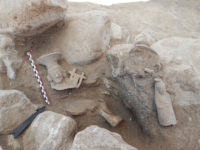 Another first for this season’s dig was the discovery of the Archaic pottery figurine of a woman and the remains of a pottery Sphinx. Two Archaic vases were unearthed, decorated with a woman and a male bust with an animal head on top of the human head, likely a representation of Herakles.
Another first for this season’s dig was the discovery of the Archaic pottery figurine of a woman and the remains of a pottery Sphinx. Two Archaic vases were unearthed, decorated with a woman and a male bust with an animal head on top of the human head, likely a representation of Herakles.
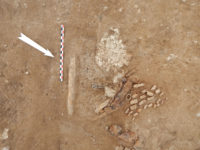 There was also one gold artifact that by some miracle eluded grave robbers: a funerary mask. It was found in a grave topped with a slate cover. The grave had been disturbed, but the thieves neglected to abscond with the mask, a gold ring, a silver double fork, iron swords and spearheads, amber beads and a bronze pot.
There was also one gold artifact that by some miracle eluded grave robbers: a funerary mask. It was found in a grave topped with a slate cover. The grave had been disturbed, but the thieves neglected to abscond with the mask, a gold ring, a silver double fork, iron swords and spearheads, amber beads and a bronze pot.
The excavation of the Achlada cemetery is ongoing, part of a salvage archaeology project to rescue whatever may be found as the ancient site is located on private property belonging to a lignite mining operation.
